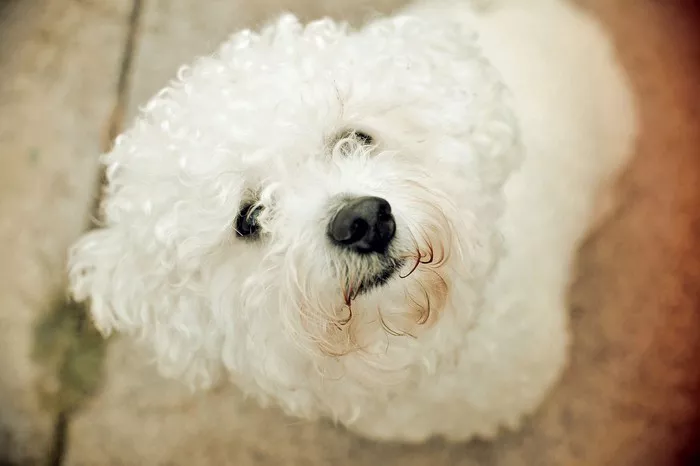Bichon Frises are adored for their fluffy white coats and cheerful personalities, but many owners struggle with tear stains—the reddish-brown streaks beneath their eyes. These stains not only affect their appearance but can also indicate underlying health or care issues. This article explores the causes of tear stains in Bichons, practical solutions, and preventive measures to keep your pet healthy and vibrant.
Understanding Tear Stains in Bichons
Tear stains result from excessive tearing (epiphora) combined with the oxidation of tear pigments. While all dogs produce tears, Bichons are particularly prone to visible staining due to their light-colored fur and facial structure. Below are the primary factors contributing to tear stains.
Anatomical Factors
Bichons have short nasolacrimal ducts (tear ducts) that drain tears from the eyes to the nose. If these ducts are narrow, blocked, or improperly structured, tears overflow onto the face instead of draining normally. This is often a congenital issue, especially in poorly bred Bichons.
Signs: Persistent wetness around the eyes, even without infection.
Solution: Surgical duct flushing or correction by a veterinarian may be necessary for severe cases.
Dietary Triggers
Diet plays a significant role in tear production and staining:
High Salt Intake: Excess salt in human food or low-quality dog food can overwhelm a Bichon’s kidneys, leading to increased tear production.
Food Allergies: Ingredients like corn, soy, or artificial additives may trigger inflammation and tear overproduction.
Vitamin Deficiencies: Lack of vitamins A and C weakens eye health and tear duct function.
Solutions:
- Feed hypoallergenic, low-sodium dog food formulated for small breeds.
- Add fresh, water-rich vegetables like cucumbers or apples to boost hydration.
- Avoid table scraps and opt for high-quality commercial diets with omega-3 fatty acids to reduce inflammation.
Eye Irritation and Infections
Irritants or infections can cause excessive tearing:
Long Facial Hair: Untrimmed fur around the eyes can scratch the cornea, leading to irritation and tears23.
Entropion or Ectropion: Eyelid deformities (common in Bichons) cause eyelashes to rub against the eye surface6.
Conjunctivitis: Bacterial or viral infections result in redness, discharge, and tear overflow6.
Solutions:
- Trim eye-area hair every 2–3 weeks using rounded scissors.
- Use veterinary-prescribed eye drops for infections or inflammation.
- Treat eyelid abnormalities surgically if recommended by a vet.
Ear and Dental Health
Surprisingly, ear and dental issues can worsen tear stains:
Ear Infections: Untreated ear mites or bacterial infections cause pain that radiates to the eyes, stimulating tear production.
Dental Disease: Bacteria from gum infections can spread to tear ducts, causing blockages.
Solutions:
- Clean ears weekly with a vet-approved solution.
- Brush teeth daily and schedule annual dental check-ups.
Environmental Factors
External irritants exacerbate tearing:
Dust and Pollen: Airborne allergens inflame the eyes.
Hard Water: Minerals in tap water can stain fur when used for cleaning.
Stress: Anxiety from loneliness or changes in routine may increase tear production.
Solutions:
- Wipe the face daily with filtered or distilled water and a soft cloth.
- Use air purifiers to reduce indoor allergens.
- Provide interactive toys to alleviate boredom and stress.
How to Manage and Prevent Tear Stains
Step 1: Daily Cleaning Routine
Gentle Wiping: Use a damp, hypoallergenic cloth or pet-safe wipe to remove tear residue.
Tear Stain Removers: Apply vet-approved solutions containing boric acid or herbal extracts to break down stains.
Step 2: Grooming Adjustments
Regular Trims: Keep hair around the eyes short to prevent irritation.
Bathing: Bathe your Bichon every 3–4 weeks with whitening shampoo to minimize staining.
Step 3: Dietary Upgrades
Probiotics: Supplements like yogurt or specialized powders improve gut health and reduce allergy-related tearing.
Hydration: Encourage water intake by adding broth or wet food to meals.
Step 4: Veterinary Care
Diagnostic Tests: Bloodwork or imaging can identify duct blockages or infections.
Medications: Antibiotics or anti-inflammatory drugs treat underlying conditions.
When to Seek Professional Help
Consult a veterinarian if:
- Tear stains persist despite home care.
- There’s swelling, pus, or foul odor around the eyes.
- Your Bichon shows signs of pain, such as pawing at the face.
Conclusion
Tear stains in Bichon Frises stem from a mix of genetics, diet, and environmental factors. While they’re rarely life-threatening, addressing the root cause early improves your dog’s comfort and appearance. Consistent grooming, a balanced diet, and proactive veterinary care are key to keeping your Bichon’s face bright and healthy.
Related Topics:
HOW MANY TIMES A DAY SHOULD A BICHON FRISE EAT?
WHAT SHOULD I FEED MY BICHON FRISE
IS THE MALE OR FEMALE BICHON FRISE BETTER?


